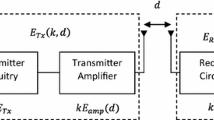Abstract
This paper proposes a cost and sub-epoch based stable energy-efficient clustering (CSSEEC) algorithm for heterogeneous wireless sensor networks. In this paper, we provide a cost function for cluster heads selection and a sub-epoch to re-stands the previously selected cluster heads as normal nodes in cluster head selection process for future rounds. Cost function alleviates the energy consumption of sensor nodes by optimum selection of cluster heads and modified sub-epoch makes the energy balance among the normal nodes. Thereby, the performance parameters like stability period, usable period, throughput and network lifetime are improved remarkably. It is also discerned that the stability period is the paramount parameter than others. By improving this parameter, overall performance of network is improved. Simulation results verified that proposed CSSEEC protocol is more efficient than existing protocols.









Similar content being viewed by others
References
Tyagi, S., & Kumar, N. (2013). A systematic review on clustering and routing techniques based upon leach protocol for wireless sensor networks. Journal of Network and Computer Applications, 36(2), 623–645.
Shen, H., & Bai, G. (2016). Routing in wireless multimedia sensor networks: A survey and challenges ahead. Journal of Network and Computer Applications, 71, 30–49.
Arora, V. K., Sharma, V., & Sachdeva, M. (2016). A survey on leach and other’s routing protocols in wireless sensor network. Optik-International Journal for Light and Electron Optics, 127(16), 6590–6600.
Kumar, L., Sharma, V., & Singh, A. (2017). Feasibility and modelling for convergence of optical-wireless network-a review. AEU International Journal of Electronics and Communications, 80, 144–156.
Alyaoui, N., Kachouri, A., Zaatouri, I., & Guiloufi, A. B. (2017). A comparative study of the energy efficient clustering protocols in heterogeneous and homogeneous wireless sensor networks. Wireless Personal Communications, 97(4), 6453–6468.
Randhawa, S., & Jain, S. (2017). Data aggregation in wireless sensor networks: Previous research, current status and future directions. Wireless Personal Communications, 97(3), 3355–3425.
Ettus, M. (1998). System capacity, latency, and power consumption in multihop-routed ss-cdma wireless networks. In Radio and wireless conference, 1998. RAWCON 98 (pp. 55–58). IEEE.
Sen, F., Bing, Q., & Liangrui, T. (2011). An improved energy-efficient pegasis-based protocol in wireless sensor networks. In 2011 Eighth international conference on fuzzy systems and knowledge discovery (FSKD) (Vol. 4, pp. 2230–2233). IEEE.
Luo, H., Ye, F., Cheng, J., Lu, S., & Zhang, L. (2005). Ttdd: Two-tier data dissemination in large-scale wireless sensor networks. Wireless Networks, 11(1–2), 161–175.
Zhen, H., Li, Y., & ZHANG, G.-J. (2013). Efficient and dynamic clustering scheme for heterogeneous multi-level wireless sensor networks. Acta Automatica Sinica, 39(4), 454–460.
Pantazis, N. A., Nikolidakis, S. A., & Vergados, D. D. (2013). Energy-efficient routing protocols in wireless sensor networks: A survey. IEEE Communications Surveys and Tutorials, 15(2), 551–591.
Mottaghi, S., & Zahabi, M. R. (2015). Optimizing leach clustering algorithm with mobile sink and rendezvous nodes. AEU-International Journal of Electronics and Communications, 69(2), 507–514.
Sivaraj, C., Alphonse, P., & Janakiraman, T. (2017). Independent neighbour set based clustering algorithm for routing in wireless sensor networks. Wireless Personal Communications, 96(4), 6197–6219.
Heinzelman, W. B., Chandrakasan, A. P., & Balakrishnan, H. (2002). An application-specific protocol architecture for wireless microsensor networks. IEEE Transactions on Wireless Communications, 1(4), 660–670.
Smaragdakis, G., Matta, I., & Bestavros, A. (2004). Sep: A stable election protocol for clustered heterogeneous wireless sensor networks. Technical report, Boston University Computer Science Department.
Qing, L., Zhu, Q., & Wang, M. (2006). Design of a distributed energy-efficient clustering algorithm for heterogeneous wireless sensor networks. Computer Communications, 29(12), 2230–2237.
Masaeli, N., Javadi, H. H. S., & Noori, E. (2013). Optimistic selection of cluster heads based on facility location problem in cluster-based routing protocols. Wireless Personal Communications, 72(4), 2721–2740.
Wang, M.-Y., Ding, J., Chen, W.-P., & Guan, W.-Q. (2015). Search: A stochastic election approach for heterogeneous wireless sensor networks. IEEE Communications Letters, 19(3), 443–446.
Mekonnen, M. T., & Rao, K. N. (2017). Cluster optimization based on metaheuristic algorithms in wireless sensor networks. Wireless Personal Communications, 97(2), 2633–2647.
Elshrkawey, M., Elsherif, S. M., & Wahed, M. E. (2018). An enhancement approach for reducing the energy consumption in wireless sensor networks. Journal of King Saud University-Computer and Information Sciences, 30, 259–267.
Arasu, K., & Ganesan, R. (2018). Effective implementation of energy aware routing for wireless sensor network. Materials Today Proceedings, 5(1), 1186–1193.
Li, C., Bai, J., Gu, J., Yan, X., & Luo, Y. (2018). Clustering routing based on mixed integer programming for heterogeneous wireless sensor networks. Ad Hoc Networks, 72, 81–90.
Arora, V. K., Sharma, V., & Sachdeva, M. (2016). A survey on leach and others routing protocols in wireless sensor network. Optik-International Journal for Light and Electron Optics, 127(16), 6590–6600.
Furuta, T., Sasaki, M., Ishizaki, F., Suzuki, A., & Miyazawa, H. (2009). A new clustering model of wireless sensor networks using facility location theory. Journal of the Operations Research Society of Japan, 52(4), 366–376.
Ding, X.-X., Ling, M., Wang, Z.-J., & Song, F.-L. (2017). Dk-leach: An optimized cluster structure routing method based on leach in wireless sensor networks. Wireless Personal Communications, 96(4), 6369–6379.
Author information
Authors and Affiliations
Corresponding author
Additional information
Publisher's Note
Springer Nature remains neutral with regard to jurisdictional claims in published maps and institutional affiliations.
Rights and permissions
About this article
Cite this article
Verma, A., Rashid, T., Gautam, P.R. et al. Cost and Sub-Epoch Based Stable Energy-Efficient Clustering Algorithm for Heterogeneous Wireless Sensor Networks. Wireless Pers Commun 107, 1865–1879 (2019). https://doi.org/10.1007/s11277-019-06362-6
Published:
Issue Date:
DOI: https://doi.org/10.1007/s11277-019-06362-6




